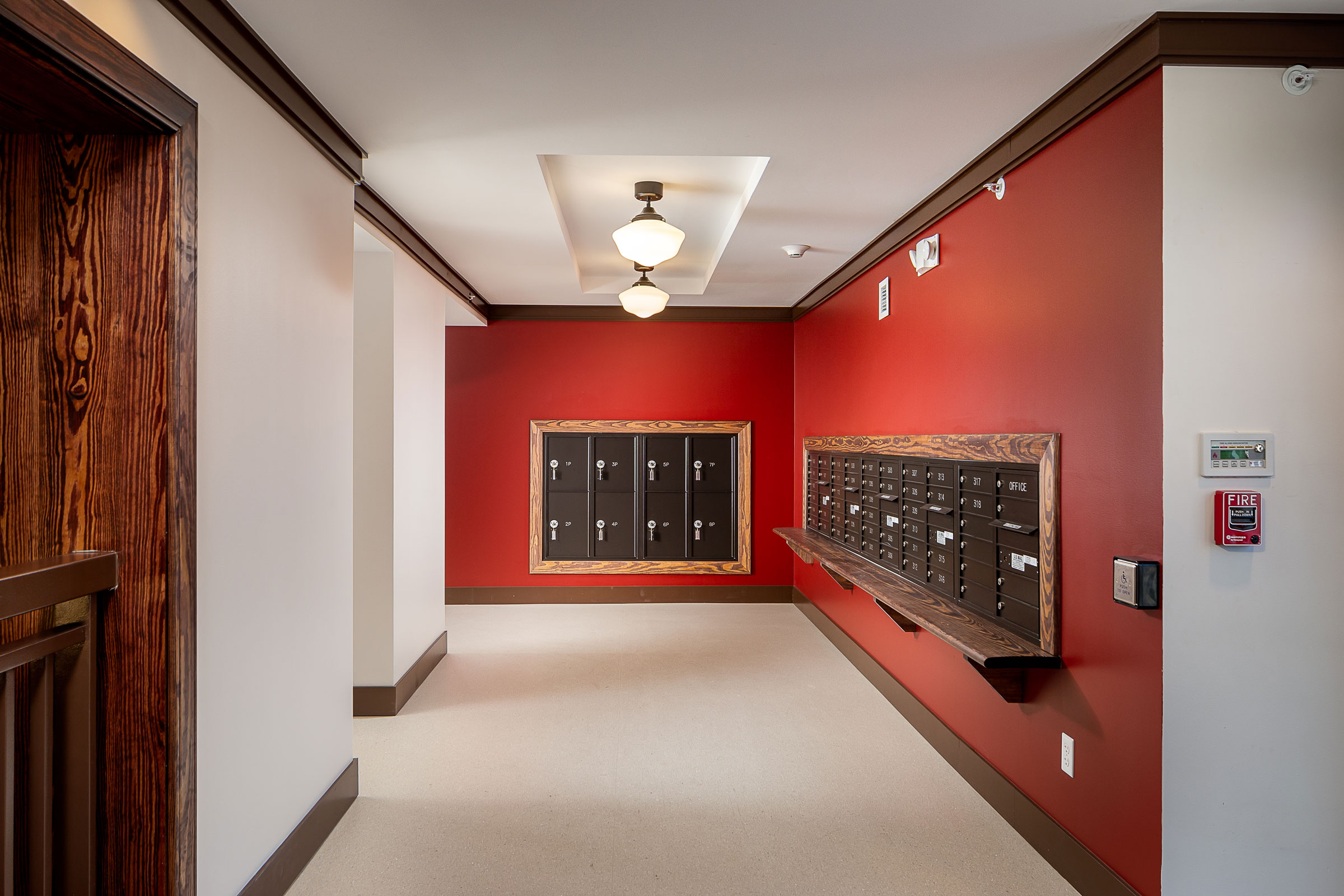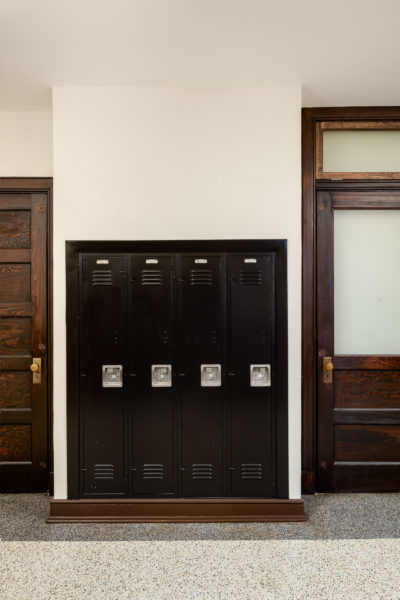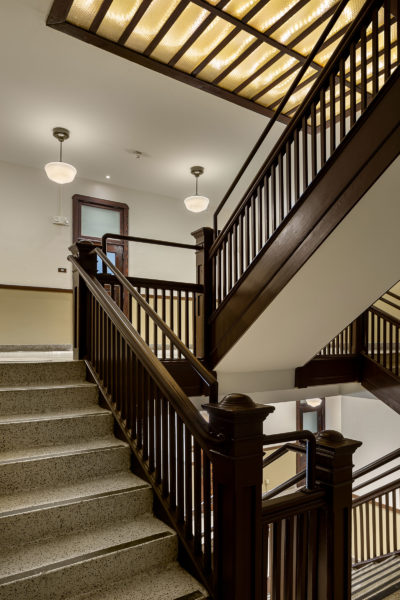Story at a glance:
- An old high school in Paris, Illinois is now home to 42 apartments for low-income seniors.
- The building retains its original gym and auditorium, offering activity and gathering spaces for residents.
- Energy efficiency and sustainability were top of mind as this project set out to achieve National Green Building Standard Certification.
An unused high school building near the center of the small town of Paris, Illinois might not seem like a place of opportunity at first glance. But with a strong sense of possibility—and the knowledge and tenacity to navigate the obstacles of limited budget and historic preservation requirements—a new vision took shape under Worn Jerabek Wiltse Architects (WJW).
Tiger Senior Apartments is now home to 42 apartments for low-income seniors, with 100% of the units designated as affordable housing either at 60% or 30% of AMI. The former high school retains its original gymnasium and auditorium spaces, offering activity and gathering spaces for residents.
With the first cohort of delighted seniors in residence, the project is in the final stages of the National Green Building Standard certification and is expected to achieve a Silver level certification. But this certification did not come easily; rather, it represents the culmination of careful balancing of historic preservation requirements, budget, and sustainability goals throughout the project.
The Challenge
This old Paris, Illinois high school was adapted to become Tiger Senior Apartments. Image courtesy of WJW Architects
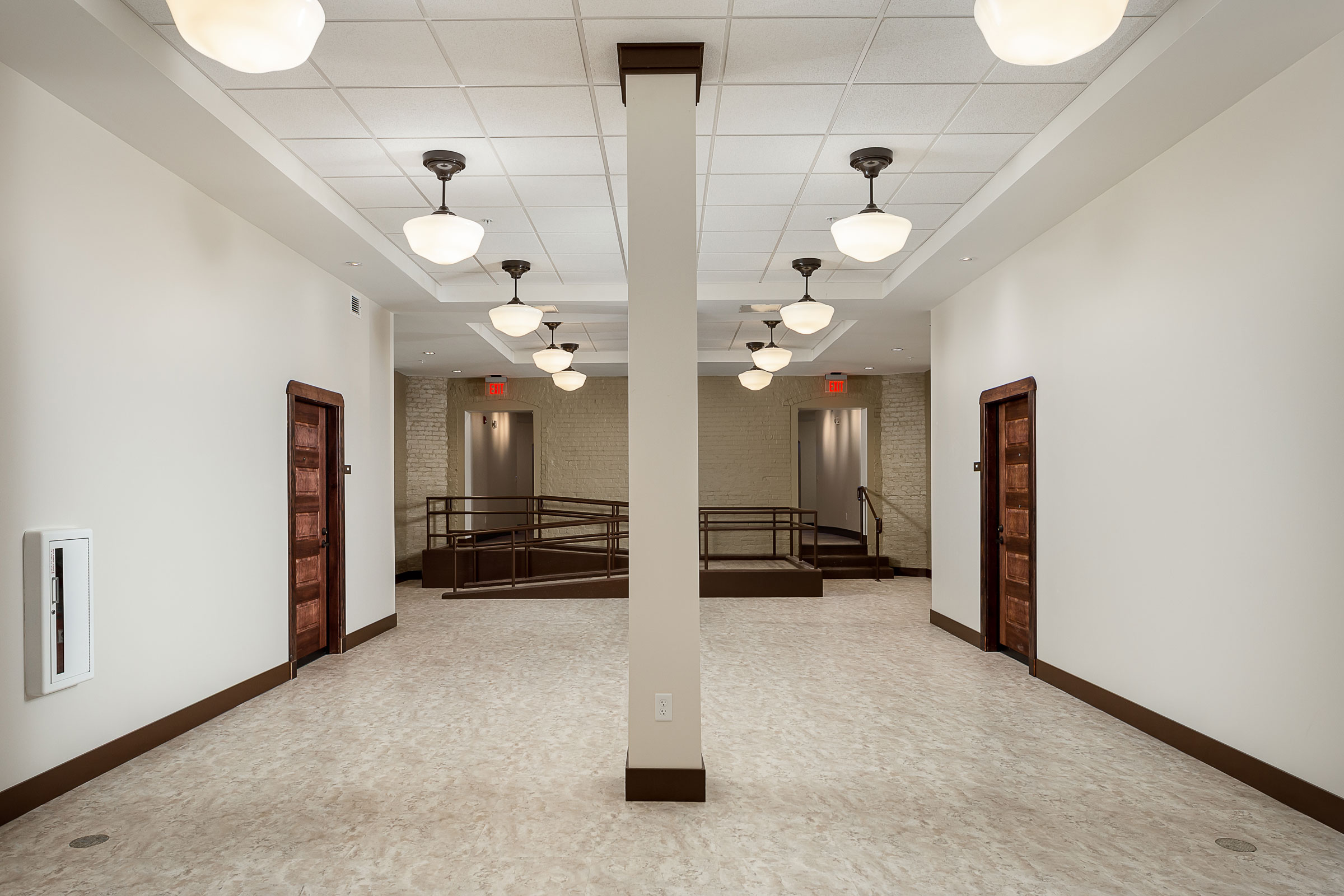
Tiger Senior Apartments. Photo by J.L. Jordan Photography
Our client imagined a redevelopment of the former school that would provide opportunities for housing, community building, and sustainable redevelopment through conversion into apartments for low-income seniors via the LIHTC program. It was clear to us at WJW that the building was well suited for conversion to apartment units, yet it was also apparent from the start that this project would pose some challenges toward our goals of sustainability, accessibility, and effective use of a very modest construction budget.
Originally constructed in 1909, the high school was expanded in 1922 and served continuously as Paris’ only high school until 2015, when a new high school was built at the edge of town. As the school function shifted away from the small town center, the building sat empty, but primed for a new life.
Taking a Green Approach
From the outset of the project the client had committed to pursuing enhanced energy efficiency and sustainability goals and to achieving National Green Building Standard Certification. They also decided to pursue both Federal and State Historic Tax credits.
The historic preservation requirements imposed by NPS and SHPO created several hurdles to navigate in order to reach our sustainability goals, yet they also afforded us unique opportunities for a higher level of sustainability than would have been achieved with a new construction building.
Insulation
One of the most significant challenges involved incorporation of new insulation at the exterior walls. The original building construction consisted of a 3-wythe masonry wall with plaster interior finish, with no insulation present in the original wall assembly. In order to meet the energy code and NGBS requirements, we were required to add new insulation to the wall. Since the exterior masonry appearance needed to be maintained, that new insulation had to go on the inside face of the wall.
After initial review, NPS would only allow new furring, insulation, and gypsum board to be a maximum of 3½ to 4 inches deep, forcing a change to spray foam insulation only, which allowed us to reduce the additional depth of new wall furring to 3 5/8 inches total. In order to maximize the R-value of the wall assembly, we also held the new metal stud furring members away from the existing masonry wall in order to provide a thermal break and ensure that the insulation was able to completely fill the new cavity.
This restriction in allowable wall furring thickness stemmed from NPS’s desire to end up with an exterior wall thickness that was as close as possible to the original and to maintain the relationship of the window to its interior jamb and sill detailing.
Windows
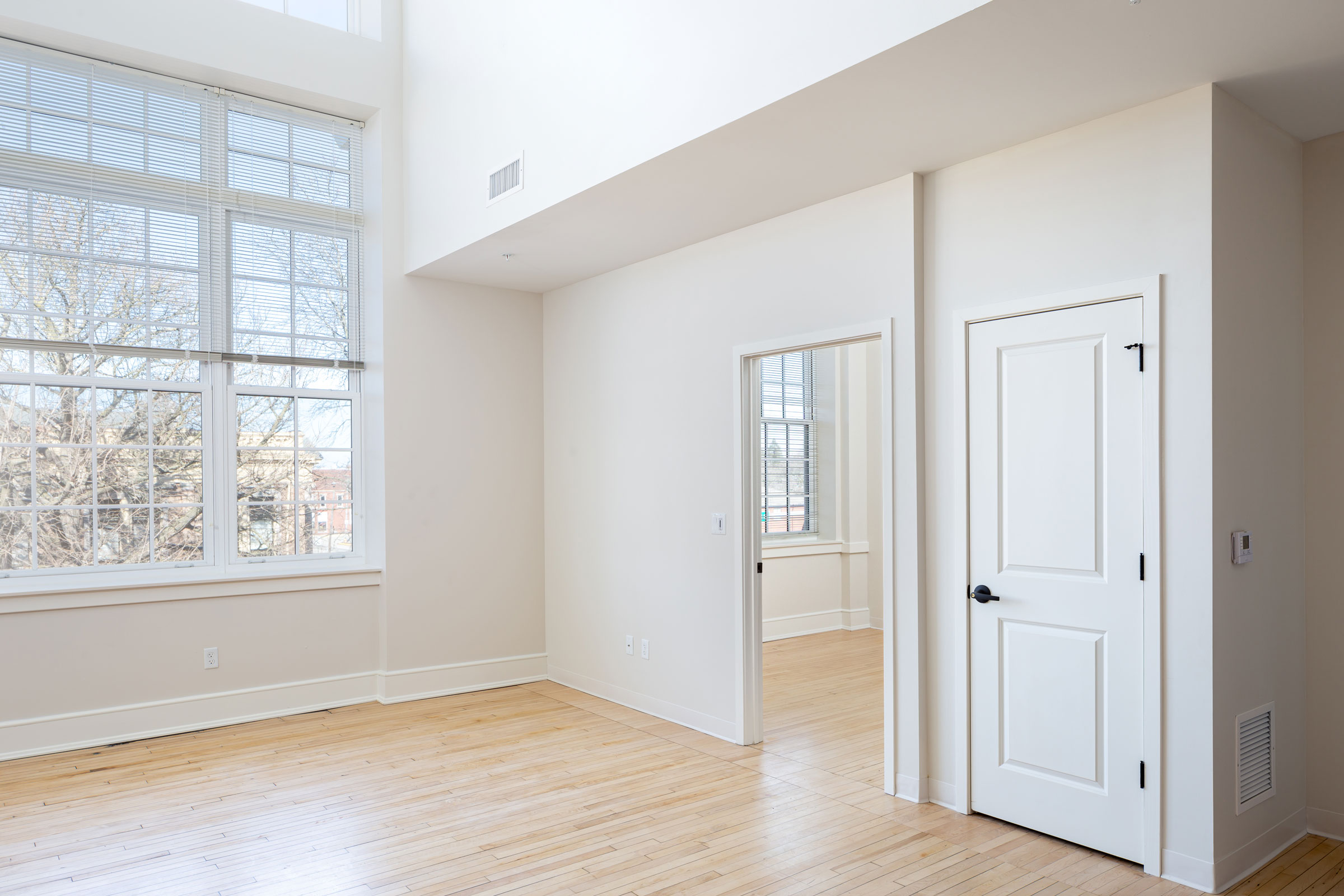
Tiger Senior Apartments. Photo by J.L. Jordan Photography
In the oldest portion of the building, all of the original window jambs and heads had a curved plaster bullnose corner detail. NPS ultimately agreed to the new wall furring and insulation if we could commit to re-creating those curved jamb and head details. Working with our historic consultant and general contractor we were able to find a product that could match the 3-inch radius corners and re-create those details with new drywall window surrounds.
Balancing historic and energy efficiency requirements for new windows presented another major challenge. The new windows had to match the historic window sizes and configurations, which were quite large. Even more challenging were the strict glazing type requirements from NPS related to reflectivity and visible light transmittance. Due to budget constraints, this resulted in a window specification that met the base level energy requirements rather than a more high-performance option that we may have otherwise pursued.
Enhanced Sustainability

Tiger Senior Apartments. Photo by J.L. Jordan Photography
However, the historic window requirements also resulted in an opportunity for enhanced sustainability. The existing historic window openings are all very large, providing exponentially more natural light than would be possible in a similar new construction project and allowing light to penetrate deeper into the units, ultimately resulting in energy savings.
As an added hurdle, the historic requirements also required us to preserve and refinish the existing hardwood floors in the new dwelling units. Due to settlement and 100 years of continuous high use, the floors presented an air infiltration concern when it came to meeting the air sealing and blower door testing requirements of both the energy code and NGBS. The contractor team needed to pay meticulous attention to the advance air sealing requirements, since we would be held to new construction requirements due to our change in occupancy. Through some trial and error and a series of sample tests, at the completion of construction all of the units were able to meet their air sealing and testing requirements.
A final challenge during design and construction related to the routing of new MEP ductwork, pipes, and conduits. Fortunately, with careful review, the engineering team was able to reroute MEP mains through existing joists and within existing vertical shafts, avoiding exposed pipes or ducts as per NPS requirements, with the exception of a few, isolated areas. This also resulted in shorter runs and savings in both labor and material costs throughout—yet another example of a challenge posed by the historic requirements that ultimately ended up benefiting the project.
In spite of the added complexity it presented, the historic preservation process wasn’t always a stumbling block—the requirements brought new dimensions to a sustainable approach.
The Successes of Adaptive Reuse
- The old lockers were saved as part of WJW’s design of Tiger Senior Apartments. Photo by J.L. Jordan Photography
- Tiger Senior Apartments. Photo by J.L. Jordan Photography
The most obvious of these was the reuse of the existing building itself. Not only did we reuse the existing shell and structural systems but also a high percentage of the interior materials and finishes, including existing plaster wall and ceiling finishes, floor material including terrazzo and wood flooring, wood trim, tin ceilings, interior wood doors, lockers and historic millwork. This high level of reuse allowed us to retain all of the embodied energy present in the historic materials, as well as a sense of historic richness.
Another aspect of enhanced sustainability unique to the historic nature of the building is its location and proximity to the center of the city. The original high school was constructed at the very center of Paris, just steps from the courthouse, original library, and a few blocks from the original business district.
As such, the apartments have an unparalleled amount of connectivity to a walkable community, as compared to a similar new construction affordable housing development that is typically located at the outskirts of town. This not only serves to reduce reliance on fossil fuels but also makes for a more equitable housing solution as many of the intended residents of this development are not able to afford a car.
In addition, the newly converted building offers sustainable features that fit easily within the historic framework, including all-electric equipment with no use of natural gas; low-flow water fixtures throughout; 100% LED lighting; high density for a rural location, with smaller-than-average dwelling unit sizes; universal design elements and enhanced accessibility; low-emitting materials and finishes and continuous bathroom exhaust fans tied into ERVs (Energy Recovery Ventilators).
Though the process of bringing Paris’ historic high school to new life required an intense team focus on finding the perfect compromises between preservation, sustainability and budget, it has become a lesson not only in fostering dynamic reuse for the community, but in the wealth of opportunities for sustainability that can be found within the confines of historic buildings.
Project Credits
Location: Paris, IL
Completion: December 2020
Size: 64,790 gross square feet
Cost: Approx. $9.6 million
Architect: Worn Jerabek Wiltse Architects
Contractor: CORE Construction Illinois
Owner/Developer: Laborers’ Home Development Corporation

